Marketing Intelligence Report: Market Analysis and Buyer Behavior
VerifiedAdded on 2020/01/28
|17
|5634
|130
Report
AI Summary
This report provides a comprehensive analysis of marketing intelligence, covering key aspects such as buyer behavior, market research techniques, and market trends. It begins by outlining the main stages of the purchase decision-making process and explores three theories of buyer behavior in terms of individuals and markets, using a real-world example. The report then delves into the factors influencing buyer behavior, including psychological, social, cultural, and economic factors. It further evaluates the relationship between brand loyalty, corporate image, and repeat purchasing. The report also examines market research techniques, differentiating between qualitative and quantitative research methods, and prepares a marketing research plan to obtain relevant information. Additionally, it includes an assessment of market size trends within a selected market, a competitor analysis of H&M, and identifies opportunities and threats for the company. The report concludes by summarizing the key findings and providing references to support the analysis.
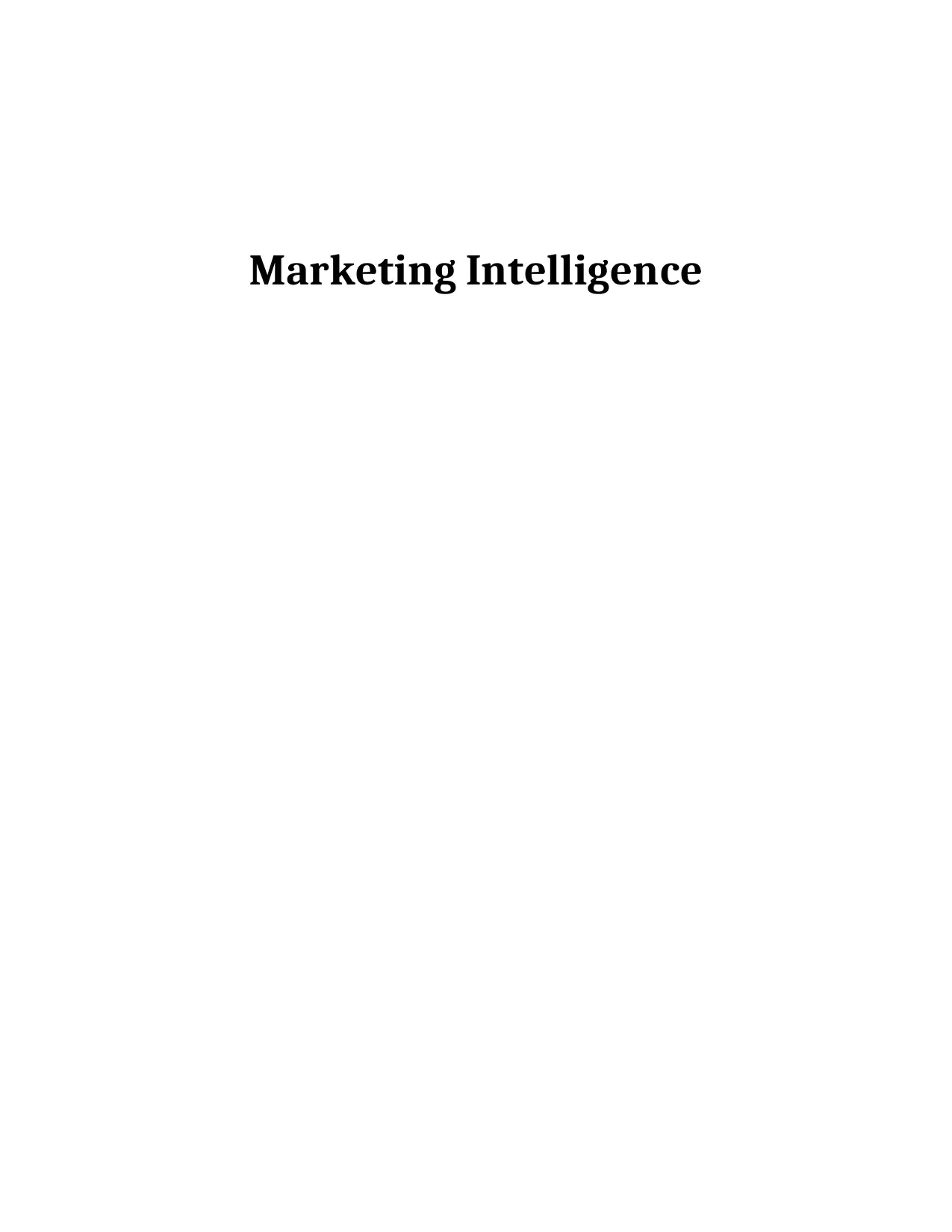
Marketing Intelligence
Paraphrase This Document
Need a fresh take? Get an instant paraphrase of this document with our AI Paraphraser
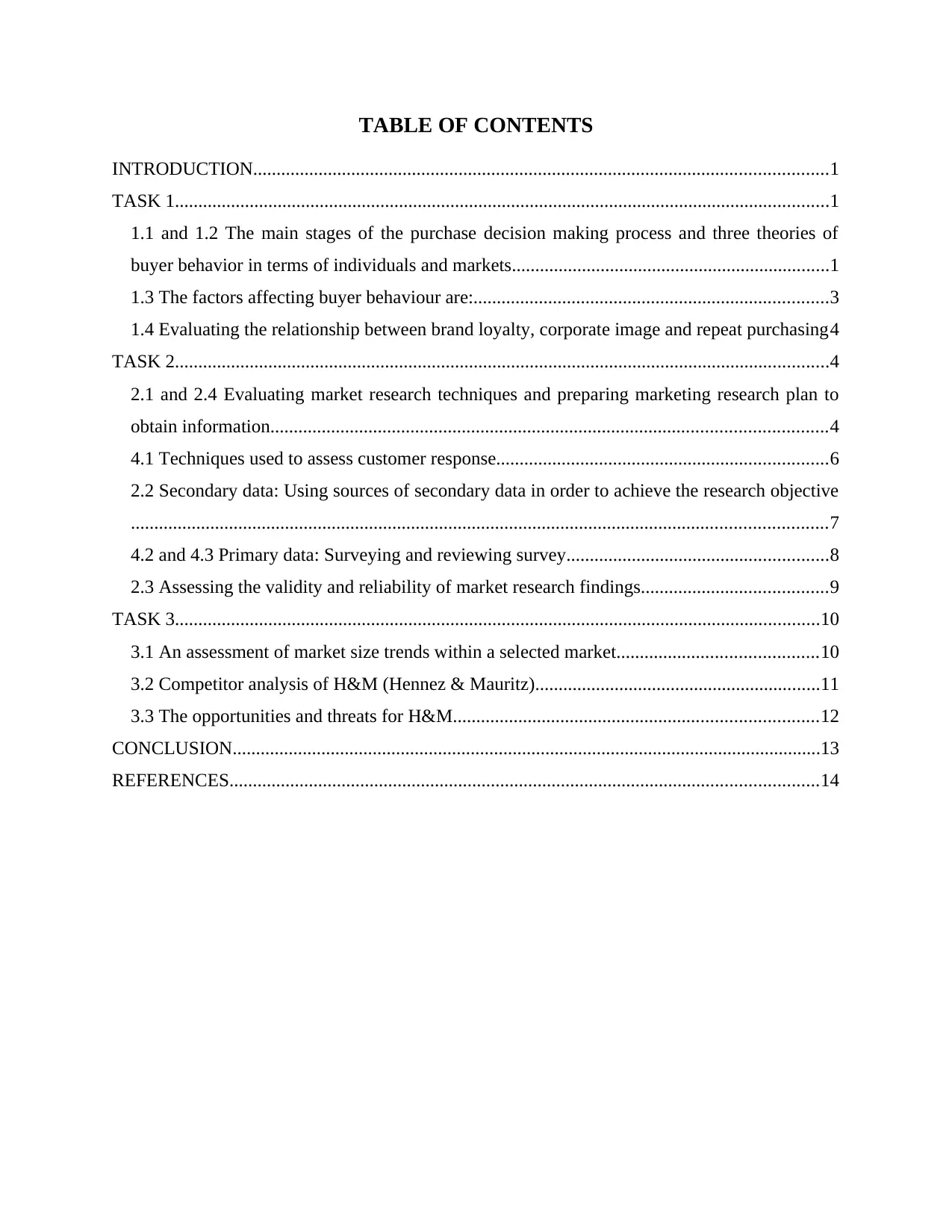
TABLE OF CONTENTS
INTRODUCTION...........................................................................................................................1
TASK 1............................................................................................................................................1
1.1 and 1.2 The main stages of the purchase decision making process and three theories of
buyer behavior in terms of individuals and markets....................................................................1
1.3 The factors affecting buyer behaviour are:............................................................................3
1.4 Evaluating the relationship between brand loyalty, corporate image and repeat purchasing4
TASK 2............................................................................................................................................4
2.1 and 2.4 Evaluating market research techniques and preparing marketing research plan to
obtain information.......................................................................................................................4
4.1 Techniques used to assess customer response.......................................................................6
2.2 Secondary data: Using sources of secondary data in order to achieve the research objective
.....................................................................................................................................................7
4.2 and 4.3 Primary data: Surveying and reviewing survey........................................................8
2.3 Assessing the validity and reliability of market research findings........................................9
TASK 3..........................................................................................................................................10
3.1 An assessment of market size trends within a selected market...........................................10
3.2 Competitor analysis of H&M (Hennez & Mauritz).............................................................11
3.3 The opportunities and threats for H&M..............................................................................12
CONCLUSION..............................................................................................................................13
REFERENCES..............................................................................................................................14
INTRODUCTION...........................................................................................................................1
TASK 1............................................................................................................................................1
1.1 and 1.2 The main stages of the purchase decision making process and three theories of
buyer behavior in terms of individuals and markets....................................................................1
1.3 The factors affecting buyer behaviour are:............................................................................3
1.4 Evaluating the relationship between brand loyalty, corporate image and repeat purchasing4
TASK 2............................................................................................................................................4
2.1 and 2.4 Evaluating market research techniques and preparing marketing research plan to
obtain information.......................................................................................................................4
4.1 Techniques used to assess customer response.......................................................................6
2.2 Secondary data: Using sources of secondary data in order to achieve the research objective
.....................................................................................................................................................7
4.2 and 4.3 Primary data: Surveying and reviewing survey........................................................8
2.3 Assessing the validity and reliability of market research findings........................................9
TASK 3..........................................................................................................................................10
3.1 An assessment of market size trends within a selected market...........................................10
3.2 Competitor analysis of H&M (Hennez & Mauritz).............................................................11
3.3 The opportunities and threats for H&M..............................................................................12
CONCLUSION..............................................................................................................................13
REFERENCES..............................................................................................................................14
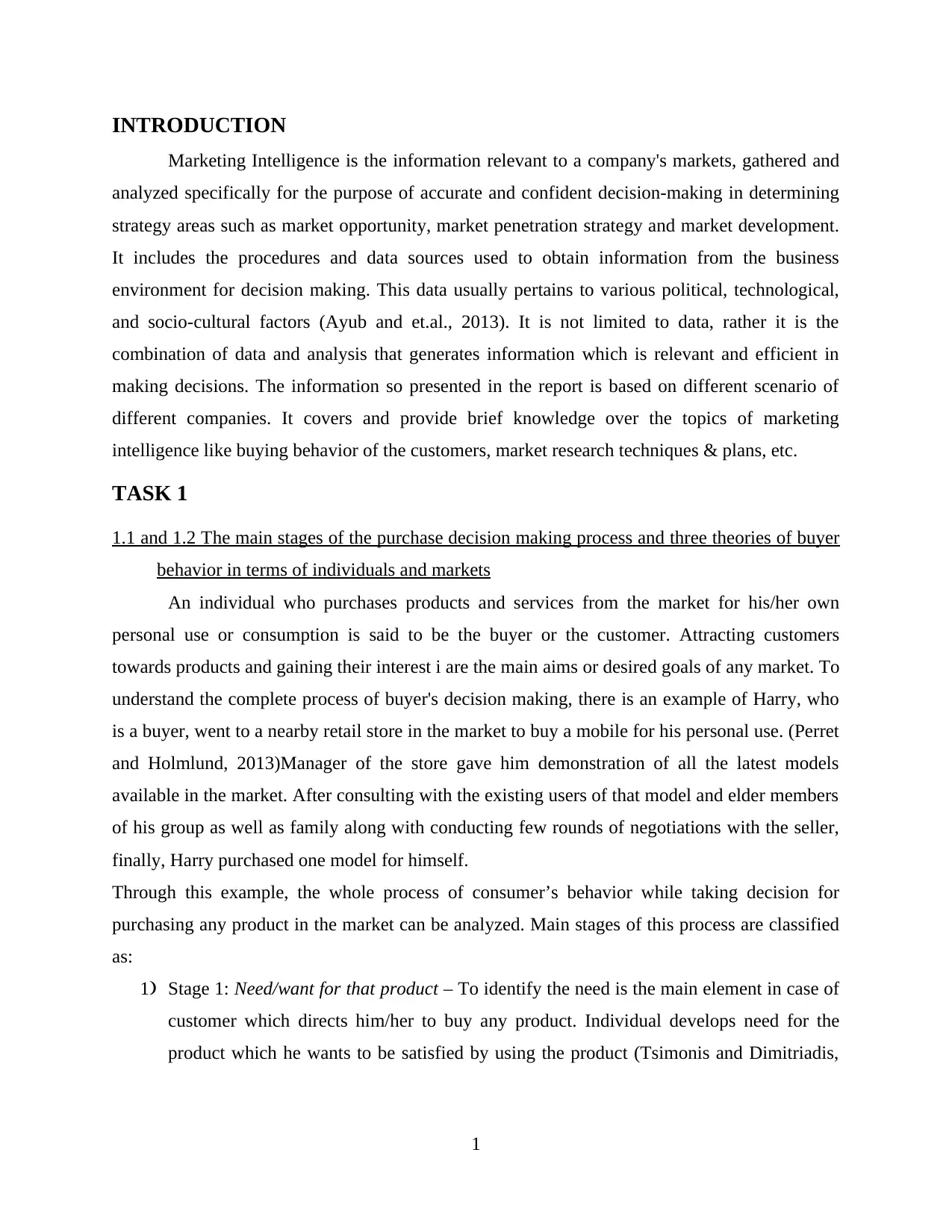
INTRODUCTION
Marketing Intelligence is the information relevant to a company's markets, gathered and
analyzed specifically for the purpose of accurate and confident decision-making in determining
strategy areas such as market opportunity, market penetration strategy and market development.
It includes the procedures and data sources used to obtain information from the business
environment for decision making. This data usually pertains to various political, technological,
and socio-cultural factors (Ayub and et.al., 2013). It is not limited to data, rather it is the
combination of data and analysis that generates information which is relevant and efficient in
making decisions. The information so presented in the report is based on different scenario of
different companies. It covers and provide brief knowledge over the topics of marketing
intelligence like buying behavior of the customers, market research techniques & plans, etc.
TASK 1
1.1 and 1.2 The main stages of the purchase decision making process and three theories of buyer
behavior in terms of individuals and markets
An individual who purchases products and services from the market for his/her own
personal use or consumption is said to be the buyer or the customer. Attracting customers
towards products and gaining their interest i are the main aims or desired goals of any market. To
understand the complete process of buyer's decision making, there is an example of Harry, who
is a buyer, went to a nearby retail store in the market to buy a mobile for his personal use. (Perret
and Holmlund, 2013)Manager of the store gave him demonstration of all the latest models
available in the market. After consulting with the existing users of that model and elder members
of his group as well as family along with conducting few rounds of negotiations with the seller,
finally, Harry purchased one model for himself.
Through this example, the whole process of consumer’s behavior while taking decision for
purchasing any product in the market can be analyzed. Main stages of this process are classified
as:
1) Stage 1: Need/want for that product – To identify the need is the main element in case of
customer which directs him/her to buy any product. Individual develops need for the
product which he wants to be satisfied by using the product (Tsimonis and Dimitriadis,
1
Marketing Intelligence is the information relevant to a company's markets, gathered and
analyzed specifically for the purpose of accurate and confident decision-making in determining
strategy areas such as market opportunity, market penetration strategy and market development.
It includes the procedures and data sources used to obtain information from the business
environment for decision making. This data usually pertains to various political, technological,
and socio-cultural factors (Ayub and et.al., 2013). It is not limited to data, rather it is the
combination of data and analysis that generates information which is relevant and efficient in
making decisions. The information so presented in the report is based on different scenario of
different companies. It covers and provide brief knowledge over the topics of marketing
intelligence like buying behavior of the customers, market research techniques & plans, etc.
TASK 1
1.1 and 1.2 The main stages of the purchase decision making process and three theories of buyer
behavior in terms of individuals and markets
An individual who purchases products and services from the market for his/her own
personal use or consumption is said to be the buyer or the customer. Attracting customers
towards products and gaining their interest i are the main aims or desired goals of any market. To
understand the complete process of buyer's decision making, there is an example of Harry, who
is a buyer, went to a nearby retail store in the market to buy a mobile for his personal use. (Perret
and Holmlund, 2013)Manager of the store gave him demonstration of all the latest models
available in the market. After consulting with the existing users of that model and elder members
of his group as well as family along with conducting few rounds of negotiations with the seller,
finally, Harry purchased one model for himself.
Through this example, the whole process of consumer’s behavior while taking decision for
purchasing any product in the market can be analyzed. Main stages of this process are classified
as:
1) Stage 1: Need/want for that product – To identify the need is the main element in case of
customer which directs him/her to buy any product. Individual develops need for the
product which he wants to be satisfied by using the product (Tsimonis and Dimitriadis,
1
⊘ This is a preview!⊘
Do you want full access?
Subscribe today to unlock all pages.

Trusted by 1+ million students worldwide
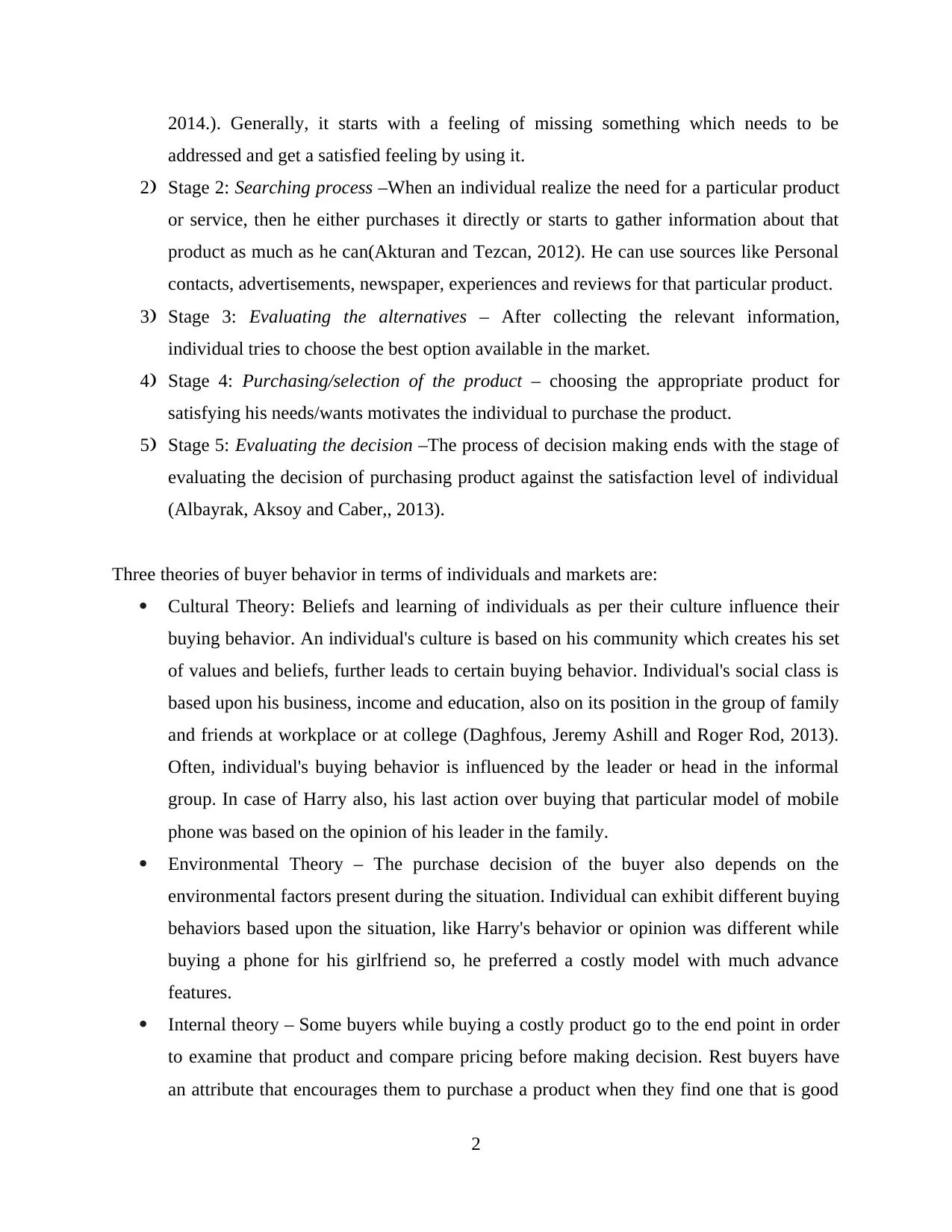
2014.). Generally, it starts with a feeling of missing something which needs to be
addressed and get a satisfied feeling by using it.
2) Stage 2: Searching process –When an individual realize the need for a particular product
or service, then he either purchases it directly or starts to gather information about that
product as much as he can(Akturan and Tezcan, 2012). He can use sources like Personal
contacts, advertisements, newspaper, experiences and reviews for that particular product.
3) Stage 3: Evaluating the alternatives – After collecting the relevant information,
individual tries to choose the best option available in the market.
4) Stage 4: Purchasing/selection of the product – choosing the appropriate product for
satisfying his needs/wants motivates the individual to purchase the product.
5) Stage 5: Evaluating the decision –The process of decision making ends with the stage of
evaluating the decision of purchasing product against the satisfaction level of individual
(Albayrak, Aksoy and Caber,, 2013).
Three theories of buyer behavior in terms of individuals and markets are:
Cultural Theory: Beliefs and learning of individuals as per their culture influence their
buying behavior. An individual's culture is based on his community which creates his set
of values and beliefs, further leads to certain buying behavior. Individual's social class is
based upon his business, income and education, also on its position in the group of family
and friends at workplace or at college (Daghfous, Jeremy Ashill and Roger Rod, 2013).
Often, individual's buying behavior is influenced by the leader or head in the informal
group. In case of Harry also, his last action over buying that particular model of mobile
phone was based on the opinion of his leader in the family.
Environmental Theory – The purchase decision of the buyer also depends on the
environmental factors present during the situation. Individual can exhibit different buying
behaviors based upon the situation, like Harry's behavior or opinion was different while
buying a phone for his girlfriend so, he preferred a costly model with much advance
features.
Internal theory – Some buyers while buying a costly product go to the end point in order
to examine that product and compare pricing before making decision. Rest buyers have
an attribute that encourages them to purchase a product when they find one that is good
2
addressed and get a satisfied feeling by using it.
2) Stage 2: Searching process –When an individual realize the need for a particular product
or service, then he either purchases it directly or starts to gather information about that
product as much as he can(Akturan and Tezcan, 2012). He can use sources like Personal
contacts, advertisements, newspaper, experiences and reviews for that particular product.
3) Stage 3: Evaluating the alternatives – After collecting the relevant information,
individual tries to choose the best option available in the market.
4) Stage 4: Purchasing/selection of the product – choosing the appropriate product for
satisfying his needs/wants motivates the individual to purchase the product.
5) Stage 5: Evaluating the decision –The process of decision making ends with the stage of
evaluating the decision of purchasing product against the satisfaction level of individual
(Albayrak, Aksoy and Caber,, 2013).
Three theories of buyer behavior in terms of individuals and markets are:
Cultural Theory: Beliefs and learning of individuals as per their culture influence their
buying behavior. An individual's culture is based on his community which creates his set
of values and beliefs, further leads to certain buying behavior. Individual's social class is
based upon his business, income and education, also on its position in the group of family
and friends at workplace or at college (Daghfous, Jeremy Ashill and Roger Rod, 2013).
Often, individual's buying behavior is influenced by the leader or head in the informal
group. In case of Harry also, his last action over buying that particular model of mobile
phone was based on the opinion of his leader in the family.
Environmental Theory – The purchase decision of the buyer also depends on the
environmental factors present during the situation. Individual can exhibit different buying
behaviors based upon the situation, like Harry's behavior or opinion was different while
buying a phone for his girlfriend so, he preferred a costly model with much advance
features.
Internal theory – Some buyers while buying a costly product go to the end point in order
to examine that product and compare pricing before making decision. Rest buyers have
an attribute that encourages them to purchase a product when they find one that is good
2
Paraphrase This Document
Need a fresh take? Get an instant paraphrase of this document with our AI Paraphraser
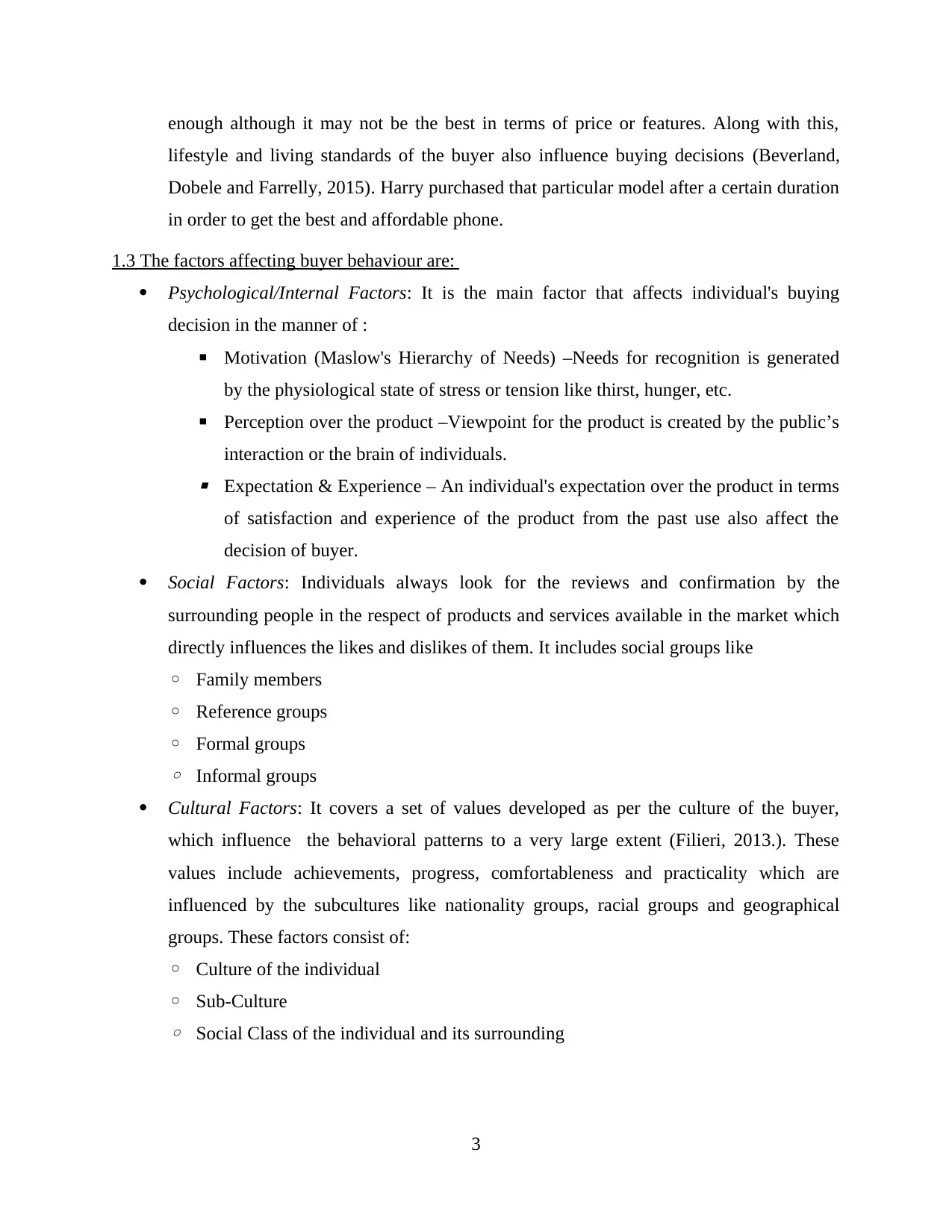
enough although it may not be the best in terms of price or features. Along with this,
lifestyle and living standards of the buyer also influence buying decisions (Beverland,
Dobele and Farrelly, 2015). Harry purchased that particular model after a certain duration
in order to get the best and affordable phone.
1.3 The factors affecting buyer behaviour are:
Psychological/Internal Factors: It is the main factor that affects individual's buying
decision in the manner of :
▪ Motivation (Maslow's Hierarchy of Needs) –Needs for recognition is generated
by the physiological state of stress or tension like thirst, hunger, etc.
▪ Perception over the product –Viewpoint for the product is created by the public’s
interaction or the brain of individuals.
▪ Expectation & Experience – An individual's expectation over the product in terms
of satisfaction and experience of the product from the past use also affect the
decision of buyer.
Social Factors: Individuals always look for the reviews and confirmation by the
surrounding people in the respect of products and services available in the market which
directly influences the likes and dislikes of them. It includes social groups like
◦ Family members
◦ Reference groups
◦ Formal groups
◦ Informal groups
Cultural Factors: It covers a set of values developed as per the culture of the buyer,
which influence the behavioral patterns to a very large extent (Filieri, 2013.). These
values include achievements, progress, comfortableness and practicality which are
influenced by the subcultures like nationality groups, racial groups and geographical
groups. These factors consist of:
◦ Culture of the individual
◦ Sub-Culture
◦ Social Class of the individual and its surrounding
3
lifestyle and living standards of the buyer also influence buying decisions (Beverland,
Dobele and Farrelly, 2015). Harry purchased that particular model after a certain duration
in order to get the best and affordable phone.
1.3 The factors affecting buyer behaviour are:
Psychological/Internal Factors: It is the main factor that affects individual's buying
decision in the manner of :
▪ Motivation (Maslow's Hierarchy of Needs) –Needs for recognition is generated
by the physiological state of stress or tension like thirst, hunger, etc.
▪ Perception over the product –Viewpoint for the product is created by the public’s
interaction or the brain of individuals.
▪ Expectation & Experience – An individual's expectation over the product in terms
of satisfaction and experience of the product from the past use also affect the
decision of buyer.
Social Factors: Individuals always look for the reviews and confirmation by the
surrounding people in the respect of products and services available in the market which
directly influences the likes and dislikes of them. It includes social groups like
◦ Family members
◦ Reference groups
◦ Formal groups
◦ Informal groups
Cultural Factors: It covers a set of values developed as per the culture of the buyer,
which influence the behavioral patterns to a very large extent (Filieri, 2013.). These
values include achievements, progress, comfortableness and practicality which are
influenced by the subcultures like nationality groups, racial groups and geographical
groups. These factors consist of:
◦ Culture of the individual
◦ Sub-Culture
◦ Social Class of the individual and its surrounding
3
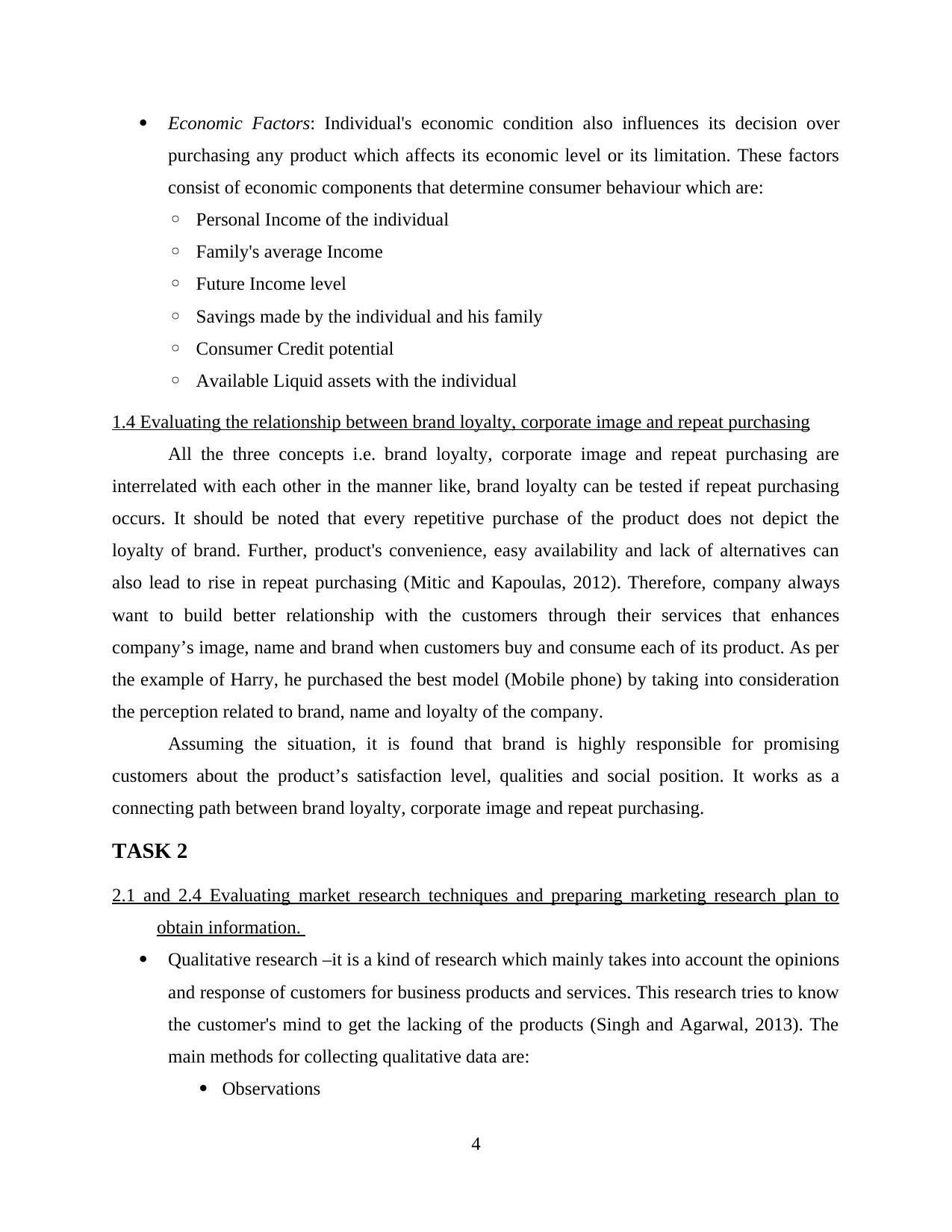
Economic Factors: Individual's economic condition also influences its decision over
purchasing any product which affects its economic level or its limitation. These factors
consist of economic components that determine consumer behaviour which are:
◦ Personal Income of the individual
◦ Family's average Income
◦ Future Income level
◦ Savings made by the individual and his family
◦ Consumer Credit potential
◦ Available Liquid assets with the individual
1.4 Evaluating the relationship between brand loyalty, corporate image and repeat purchasing
All the three concepts i.e. brand loyalty, corporate image and repeat purchasing are
interrelated with each other in the manner like, brand loyalty can be tested if repeat purchasing
occurs. It should be noted that every repetitive purchase of the product does not depict the
loyalty of brand. Further, product's convenience, easy availability and lack of alternatives can
also lead to rise in repeat purchasing (Mitic and Kapoulas, 2012). Therefore, company always
want to build better relationship with the customers through their services that enhances
company’s image, name and brand when customers buy and consume each of its product. As per
the example of Harry, he purchased the best model (Mobile phone) by taking into consideration
the perception related to brand, name and loyalty of the company.
Assuming the situation, it is found that brand is highly responsible for promising
customers about the product’s satisfaction level, qualities and social position. It works as a
connecting path between brand loyalty, corporate image and repeat purchasing.
TASK 2
2.1 and 2.4 Evaluating market research techniques and preparing marketing research plan to
obtain information.
Qualitative research –it is a kind of research which mainly takes into account the opinions
and response of customers for business products and services. This research tries to know
the customer's mind to get the lacking of the products (Singh and Agarwal, 2013). The
main methods for collecting qualitative data are:
Observations
4
purchasing any product which affects its economic level or its limitation. These factors
consist of economic components that determine consumer behaviour which are:
◦ Personal Income of the individual
◦ Family's average Income
◦ Future Income level
◦ Savings made by the individual and his family
◦ Consumer Credit potential
◦ Available Liquid assets with the individual
1.4 Evaluating the relationship between brand loyalty, corporate image and repeat purchasing
All the three concepts i.e. brand loyalty, corporate image and repeat purchasing are
interrelated with each other in the manner like, brand loyalty can be tested if repeat purchasing
occurs. It should be noted that every repetitive purchase of the product does not depict the
loyalty of brand. Further, product's convenience, easy availability and lack of alternatives can
also lead to rise in repeat purchasing (Mitic and Kapoulas, 2012). Therefore, company always
want to build better relationship with the customers through their services that enhances
company’s image, name and brand when customers buy and consume each of its product. As per
the example of Harry, he purchased the best model (Mobile phone) by taking into consideration
the perception related to brand, name and loyalty of the company.
Assuming the situation, it is found that brand is highly responsible for promising
customers about the product’s satisfaction level, qualities and social position. It works as a
connecting path between brand loyalty, corporate image and repeat purchasing.
TASK 2
2.1 and 2.4 Evaluating market research techniques and preparing marketing research plan to
obtain information.
Qualitative research –it is a kind of research which mainly takes into account the opinions
and response of customers for business products and services. This research tries to know
the customer's mind to get the lacking of the products (Singh and Agarwal, 2013). The
main methods for collecting qualitative data are:
Observations
4
⊘ This is a preview!⊘
Do you want full access?
Subscribe today to unlock all pages.

Trusted by 1+ million students worldwide
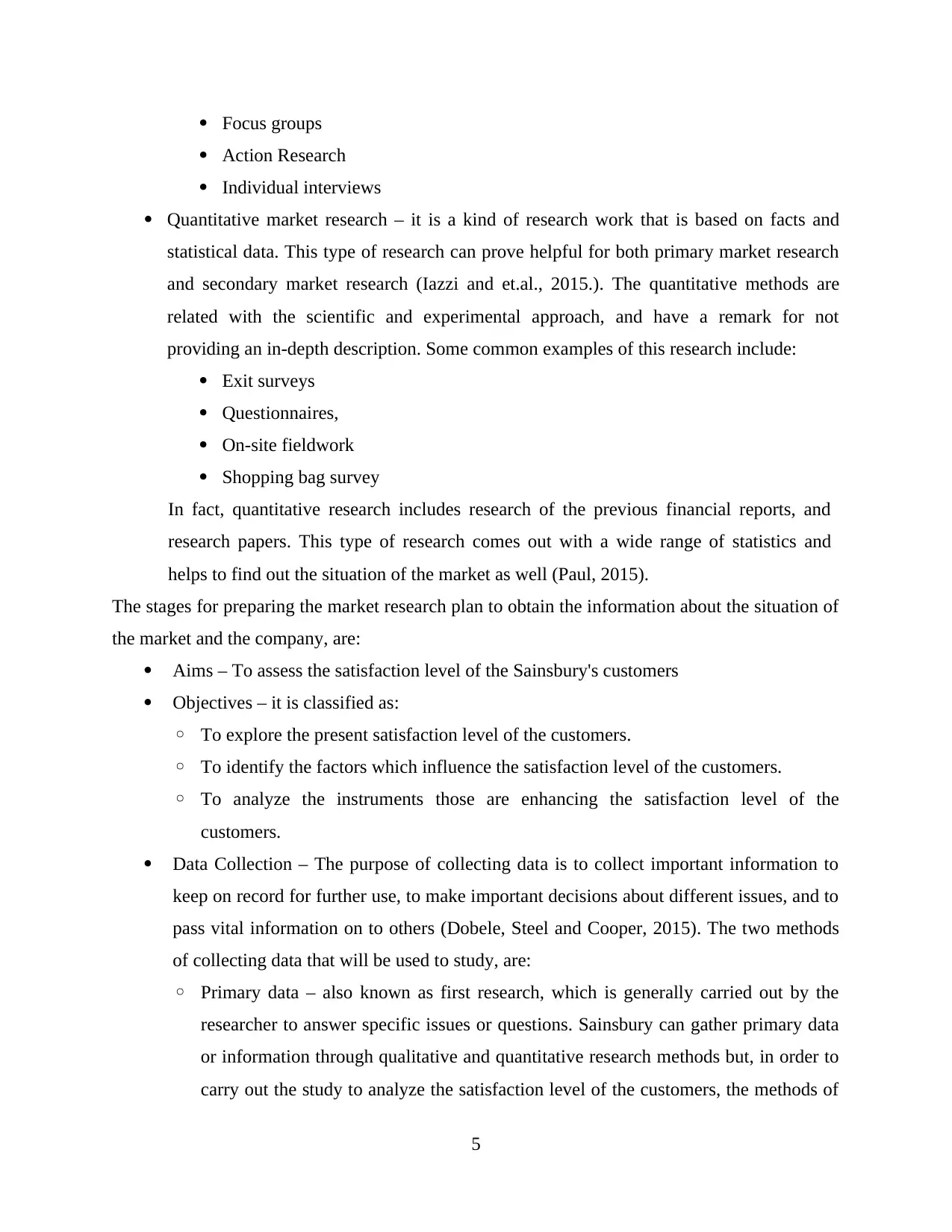
Focus groups
Action Research
Individual interviews
Quantitative market research – it is a kind of research work that is based on facts and
statistical data. This type of research can prove helpful for both primary market research
and secondary market research (Iazzi and et.al., 2015.). The quantitative methods are
related with the scientific and experimental approach, and have a remark for not
providing an in-depth description. Some common examples of this research include:
Exit surveys
Questionnaires,
On-site fieldwork
Shopping bag survey
In fact, quantitative research includes research of the previous financial reports, and
research papers. This type of research comes out with a wide range of statistics and
helps to find out the situation of the market as well (Paul, 2015).
The stages for preparing the market research plan to obtain the information about the situation of
the market and the company, are:
Aims – To assess the satisfaction level of the Sainsbury's customers
Objectives – it is classified as:
◦ To explore the present satisfaction level of the customers.
◦ To identify the factors which influence the satisfaction level of the customers.
◦ To analyze the instruments those are enhancing the satisfaction level of the
customers.
Data Collection – The purpose of collecting data is to collect important information to
keep on record for further use, to make important decisions about different issues, and to
pass vital information on to others (Dobele, Steel and Cooper, 2015). The two methods
of collecting data that will be used to study, are:
◦ Primary data – also known as first research, which is generally carried out by the
researcher to answer specific issues or questions. Sainsbury can gather primary data
or information through qualitative and quantitative research methods but, in order to
carry out the study to analyze the satisfaction level of the customers, the methods of
5
Action Research
Individual interviews
Quantitative market research – it is a kind of research work that is based on facts and
statistical data. This type of research can prove helpful for both primary market research
and secondary market research (Iazzi and et.al., 2015.). The quantitative methods are
related with the scientific and experimental approach, and have a remark for not
providing an in-depth description. Some common examples of this research include:
Exit surveys
Questionnaires,
On-site fieldwork
Shopping bag survey
In fact, quantitative research includes research of the previous financial reports, and
research papers. This type of research comes out with a wide range of statistics and
helps to find out the situation of the market as well (Paul, 2015).
The stages for preparing the market research plan to obtain the information about the situation of
the market and the company, are:
Aims – To assess the satisfaction level of the Sainsbury's customers
Objectives – it is classified as:
◦ To explore the present satisfaction level of the customers.
◦ To identify the factors which influence the satisfaction level of the customers.
◦ To analyze the instruments those are enhancing the satisfaction level of the
customers.
Data Collection – The purpose of collecting data is to collect important information to
keep on record for further use, to make important decisions about different issues, and to
pass vital information on to others (Dobele, Steel and Cooper, 2015). The two methods
of collecting data that will be used to study, are:
◦ Primary data – also known as first research, which is generally carried out by the
researcher to answer specific issues or questions. Sainsbury can gather primary data
or information through qualitative and quantitative research methods but, in order to
carry out the study to analyze the satisfaction level of the customers, the methods of
5
Paraphrase This Document
Need a fresh take? Get an instant paraphrase of this document with our AI Paraphraser
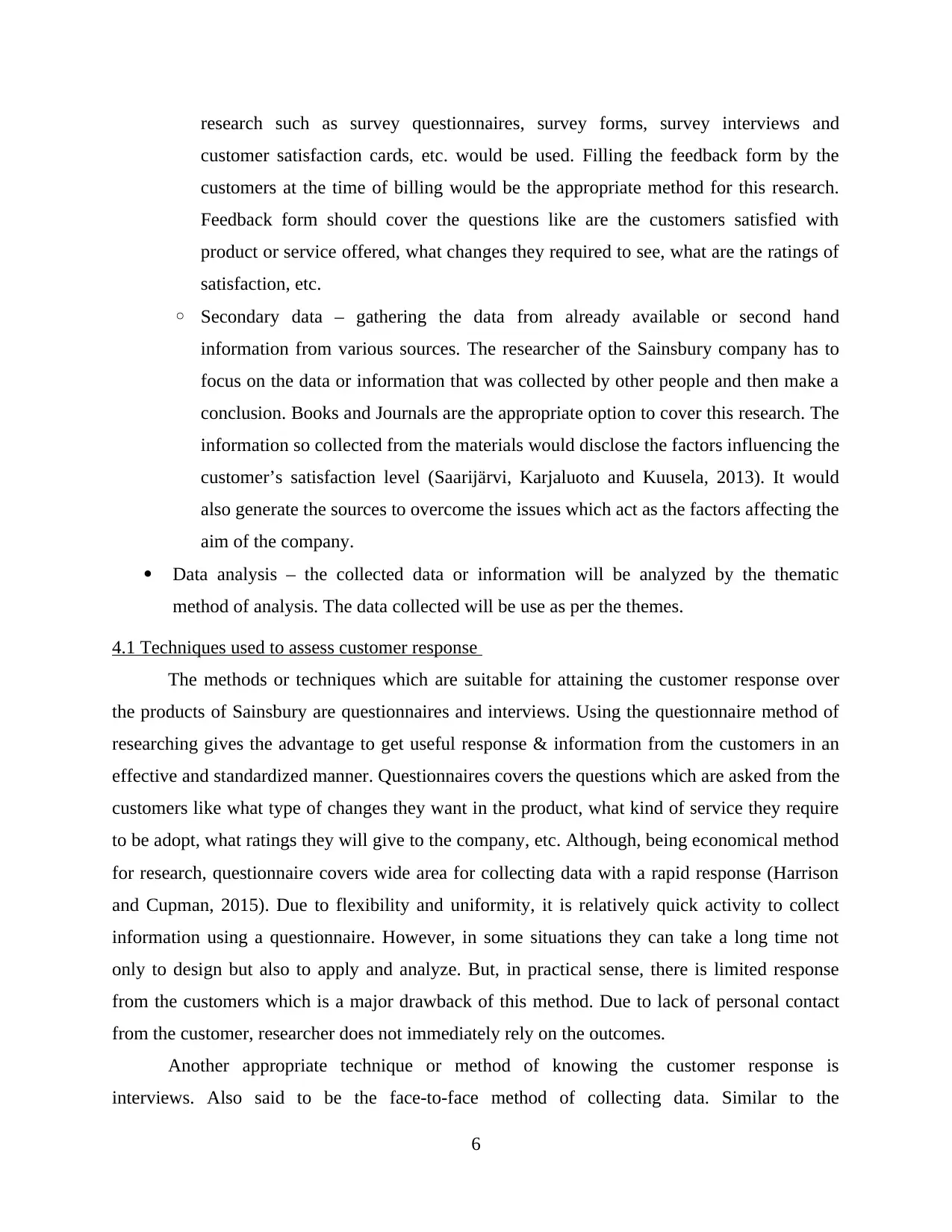
research such as survey questionnaires, survey forms, survey interviews and
customer satisfaction cards, etc. would be used. Filling the feedback form by the
customers at the time of billing would be the appropriate method for this research.
Feedback form should cover the questions like are the customers satisfied with
product or service offered, what changes they required to see, what are the ratings of
satisfaction, etc.
◦ Secondary data – gathering the data from already available or second hand
information from various sources. The researcher of the Sainsbury company has to
focus on the data or information that was collected by other people and then make a
conclusion. Books and Journals are the appropriate option to cover this research. The
information so collected from the materials would disclose the factors influencing the
customer’s satisfaction level (Saarijärvi, Karjaluoto and Kuusela, 2013). It would
also generate the sources to overcome the issues which act as the factors affecting the
aim of the company.
Data analysis – the collected data or information will be analyzed by the thematic
method of analysis. The data collected will be use as per the themes.
4.1 Techniques used to assess customer response
The methods or techniques which are suitable for attaining the customer response over
the products of Sainsbury are questionnaires and interviews. Using the questionnaire method of
researching gives the advantage to get useful response & information from the customers in an
effective and standardized manner. Questionnaires covers the questions which are asked from the
customers like what type of changes they want in the product, what kind of service they require
to be adopt, what ratings they will give to the company, etc. Although, being economical method
for research, questionnaire covers wide area for collecting data with a rapid response (Harrison
and Cupman, 2015). Due to flexibility and uniformity, it is relatively quick activity to collect
information using a questionnaire. However, in some situations they can take a long time not
only to design but also to apply and analyze. But, in practical sense, there is limited response
from the customers which is a major drawback of this method. Due to lack of personal contact
from the customer, researcher does not immediately rely on the outcomes.
Another appropriate technique or method of knowing the customer response is
interviews. Also said to be the face-to-face method of collecting data. Similar to the
6
customer satisfaction cards, etc. would be used. Filling the feedback form by the
customers at the time of billing would be the appropriate method for this research.
Feedback form should cover the questions like are the customers satisfied with
product or service offered, what changes they required to see, what are the ratings of
satisfaction, etc.
◦ Secondary data – gathering the data from already available or second hand
information from various sources. The researcher of the Sainsbury company has to
focus on the data or information that was collected by other people and then make a
conclusion. Books and Journals are the appropriate option to cover this research. The
information so collected from the materials would disclose the factors influencing the
customer’s satisfaction level (Saarijärvi, Karjaluoto and Kuusela, 2013). It would
also generate the sources to overcome the issues which act as the factors affecting the
aim of the company.
Data analysis – the collected data or information will be analyzed by the thematic
method of analysis. The data collected will be use as per the themes.
4.1 Techniques used to assess customer response
The methods or techniques which are suitable for attaining the customer response over
the products of Sainsbury are questionnaires and interviews. Using the questionnaire method of
researching gives the advantage to get useful response & information from the customers in an
effective and standardized manner. Questionnaires covers the questions which are asked from the
customers like what type of changes they want in the product, what kind of service they require
to be adopt, what ratings they will give to the company, etc. Although, being economical method
for research, questionnaire covers wide area for collecting data with a rapid response (Harrison
and Cupman, 2015). Due to flexibility and uniformity, it is relatively quick activity to collect
information using a questionnaire. However, in some situations they can take a long time not
only to design but also to apply and analyze. But, in practical sense, there is limited response
from the customers which is a major drawback of this method. Due to lack of personal contact
from the customer, researcher does not immediately rely on the outcomes.
Another appropriate technique or method of knowing the customer response is
interviews. Also said to be the face-to-face method of collecting data. Similar to the
6
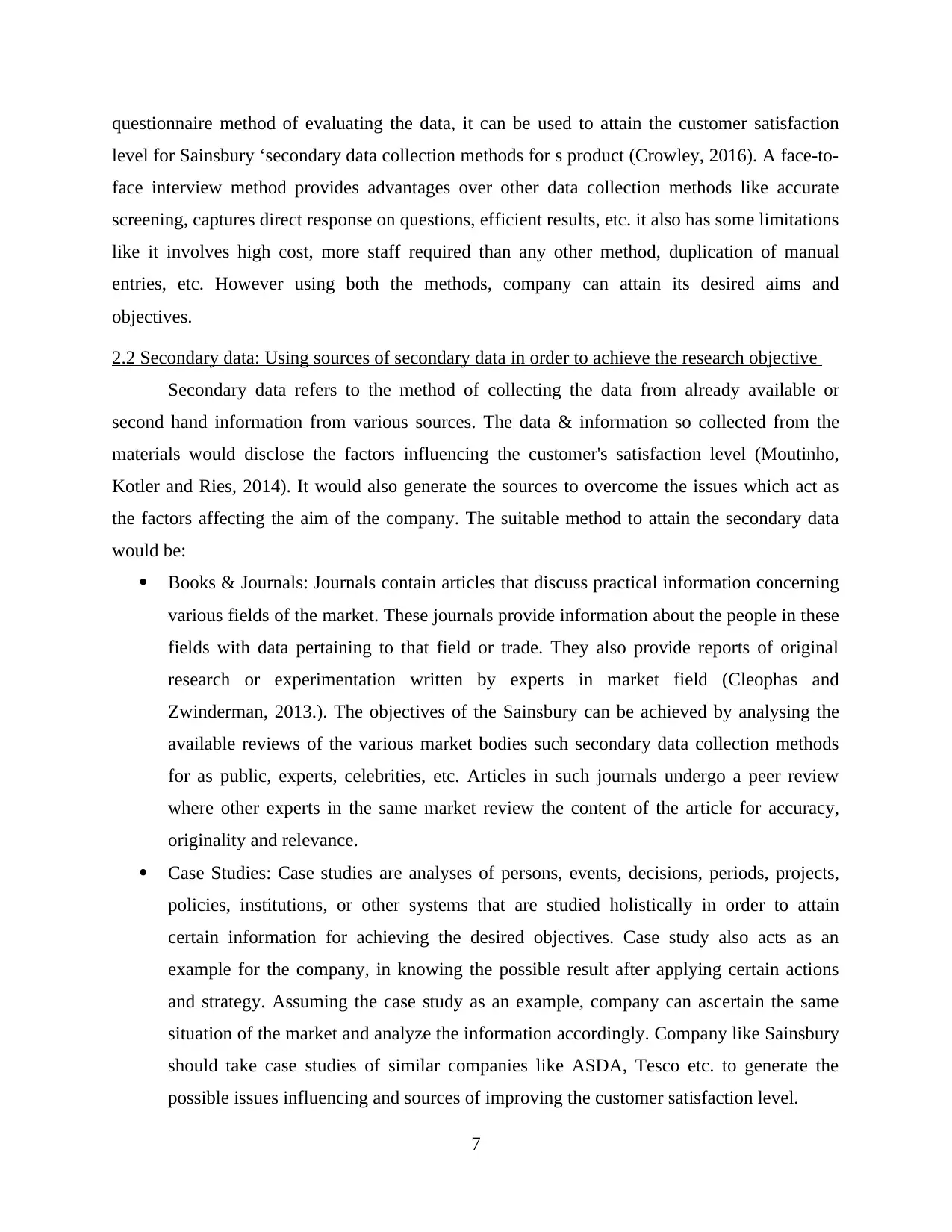
questionnaire method of evaluating the data, it can be used to attain the customer satisfaction
level for Sainsbury ‘secondary data collection methods for s product (Crowley, 2016). A face-to-
face interview method provides advantages over other data collection methods like accurate
screening, captures direct response on questions, efficient results, etc. it also has some limitations
like it involves high cost, more staff required than any other method, duplication of manual
entries, etc. However using both the methods, company can attain its desired aims and
objectives.
2.2 Secondary data: Using sources of secondary data in order to achieve the research objective
Secondary data refers to the method of collecting the data from already available or
second hand information from various sources. The data & information so collected from the
materials would disclose the factors influencing the customer's satisfaction level (Moutinho,
Kotler and Ries, 2014). It would also generate the sources to overcome the issues which act as
the factors affecting the aim of the company. The suitable method to attain the secondary data
would be:
Books & Journals: Journals contain articles that discuss practical information concerning
various fields of the market. These journals provide information about the people in these
fields with data pertaining to that field or trade. They also provide reports of original
research or experimentation written by experts in market field (Cleophas and
Zwinderman, 2013.). The objectives of the Sainsbury can be achieved by analysing the
available reviews of the various market bodies such secondary data collection methods
for as public, experts, celebrities, etc. Articles in such journals undergo a peer review
where other experts in the same market review the content of the article for accuracy,
originality and relevance.
Case Studies: Case studies are analyses of persons, events, decisions, periods, projects,
policies, institutions, or other systems that are studied holistically in order to attain
certain information for achieving the desired objectives. Case study also acts as an
example for the company, in knowing the possible result after applying certain actions
and strategy. Assuming the case study as an example, company can ascertain the same
situation of the market and analyze the information accordingly. Company like Sainsbury
should take case studies of similar companies like ASDA, Tesco etc. to generate the
possible issues influencing and sources of improving the customer satisfaction level.
7
level for Sainsbury ‘secondary data collection methods for s product (Crowley, 2016). A face-to-
face interview method provides advantages over other data collection methods like accurate
screening, captures direct response on questions, efficient results, etc. it also has some limitations
like it involves high cost, more staff required than any other method, duplication of manual
entries, etc. However using both the methods, company can attain its desired aims and
objectives.
2.2 Secondary data: Using sources of secondary data in order to achieve the research objective
Secondary data refers to the method of collecting the data from already available or
second hand information from various sources. The data & information so collected from the
materials would disclose the factors influencing the customer's satisfaction level (Moutinho,
Kotler and Ries, 2014). It would also generate the sources to overcome the issues which act as
the factors affecting the aim of the company. The suitable method to attain the secondary data
would be:
Books & Journals: Journals contain articles that discuss practical information concerning
various fields of the market. These journals provide information about the people in these
fields with data pertaining to that field or trade. They also provide reports of original
research or experimentation written by experts in market field (Cleophas and
Zwinderman, 2013.). The objectives of the Sainsbury can be achieved by analysing the
available reviews of the various market bodies such secondary data collection methods
for as public, experts, celebrities, etc. Articles in such journals undergo a peer review
where other experts in the same market review the content of the article for accuracy,
originality and relevance.
Case Studies: Case studies are analyses of persons, events, decisions, periods, projects,
policies, institutions, or other systems that are studied holistically in order to attain
certain information for achieving the desired objectives. Case study also acts as an
example for the company, in knowing the possible result after applying certain actions
and strategy. Assuming the case study as an example, company can ascertain the same
situation of the market and analyze the information accordingly. Company like Sainsbury
should take case studies of similar companies like ASDA, Tesco etc. to generate the
possible issues influencing and sources of improving the customer satisfaction level.
7
⊘ This is a preview!⊘
Do you want full access?
Subscribe today to unlock all pages.

Trusted by 1+ million students worldwide
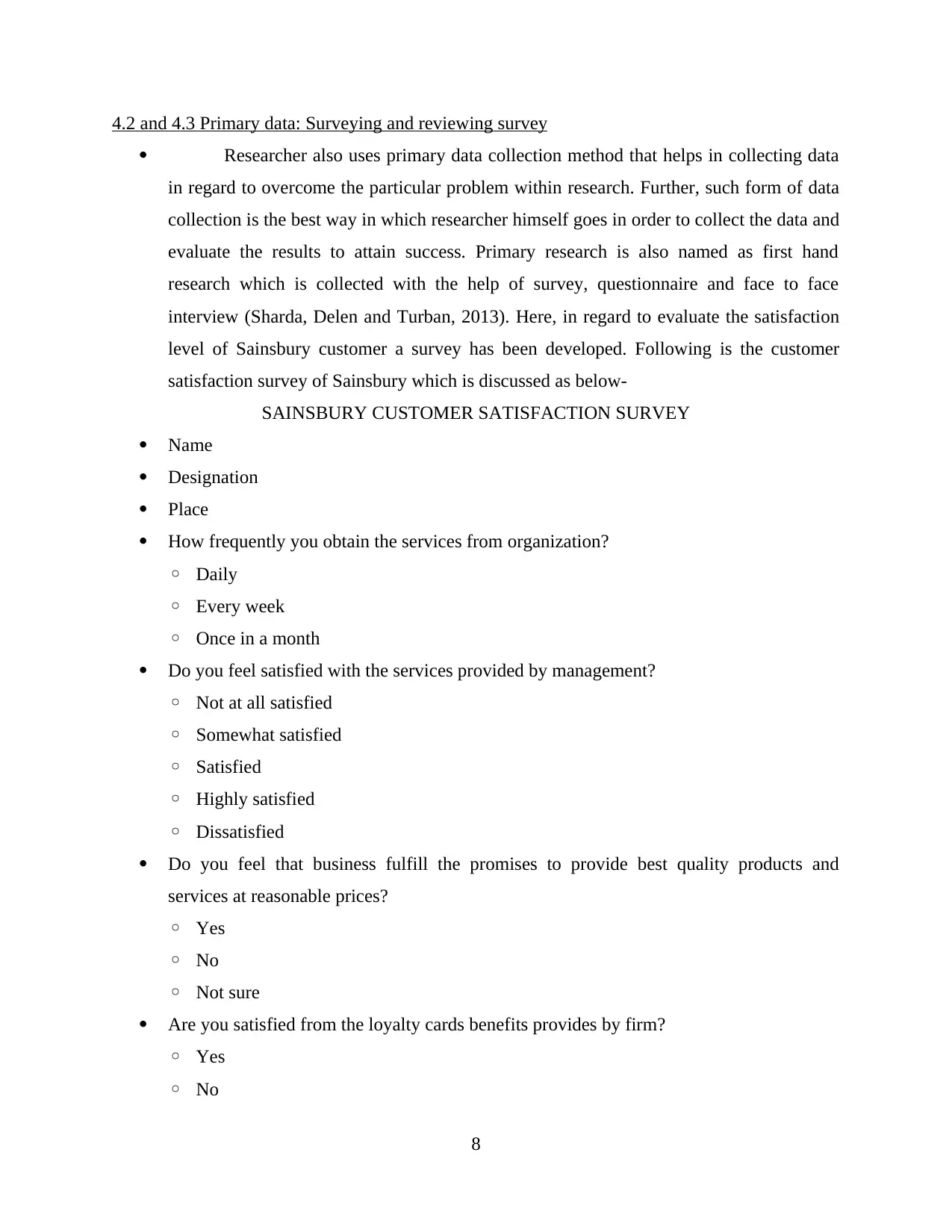
4.2 and 4.3 Primary data: Surveying and reviewing survey
Researcher also uses primary data collection method that helps in collecting data
in regard to overcome the particular problem within research. Further, such form of data
collection is the best way in which researcher himself goes in order to collect the data and
evaluate the results to attain success. Primary research is also named as first hand
research which is collected with the help of survey, questionnaire and face to face
interview (Sharda, Delen and Turban, 2013). Here, in regard to evaluate the satisfaction
level of Sainsbury customer a survey has been developed. Following is the customer
satisfaction survey of Sainsbury which is discussed as below-
SAINSBURY CUSTOMER SATISFACTION SURVEY
Name
Designation
Place
How frequently you obtain the services from organization?
◦ Daily
◦ Every week
◦ Once in a month
Do you feel satisfied with the services provided by management?
◦ Not at all satisfied
◦ Somewhat satisfied
◦ Satisfied
◦ Highly satisfied
◦ Dissatisfied
Do you feel that business fulfill the promises to provide best quality products and
services at reasonable prices?
◦ Yes
◦ No
◦ Not sure
Are you satisfied from the loyalty cards benefits provides by firm?
◦ Yes
◦ No
8
Researcher also uses primary data collection method that helps in collecting data
in regard to overcome the particular problem within research. Further, such form of data
collection is the best way in which researcher himself goes in order to collect the data and
evaluate the results to attain success. Primary research is also named as first hand
research which is collected with the help of survey, questionnaire and face to face
interview (Sharda, Delen and Turban, 2013). Here, in regard to evaluate the satisfaction
level of Sainsbury customer a survey has been developed. Following is the customer
satisfaction survey of Sainsbury which is discussed as below-
SAINSBURY CUSTOMER SATISFACTION SURVEY
Name
Designation
Place
How frequently you obtain the services from organization?
◦ Daily
◦ Every week
◦ Once in a month
Do you feel satisfied with the services provided by management?
◦ Not at all satisfied
◦ Somewhat satisfied
◦ Satisfied
◦ Highly satisfied
◦ Dissatisfied
Do you feel that business fulfill the promises to provide best quality products and
services at reasonable prices?
◦ Yes
◦ No
◦ Not sure
Are you satisfied from the loyalty cards benefits provides by firm?
◦ Yes
◦ No
8
Paraphrase This Document
Need a fresh take? Get an instant paraphrase of this document with our AI Paraphraser
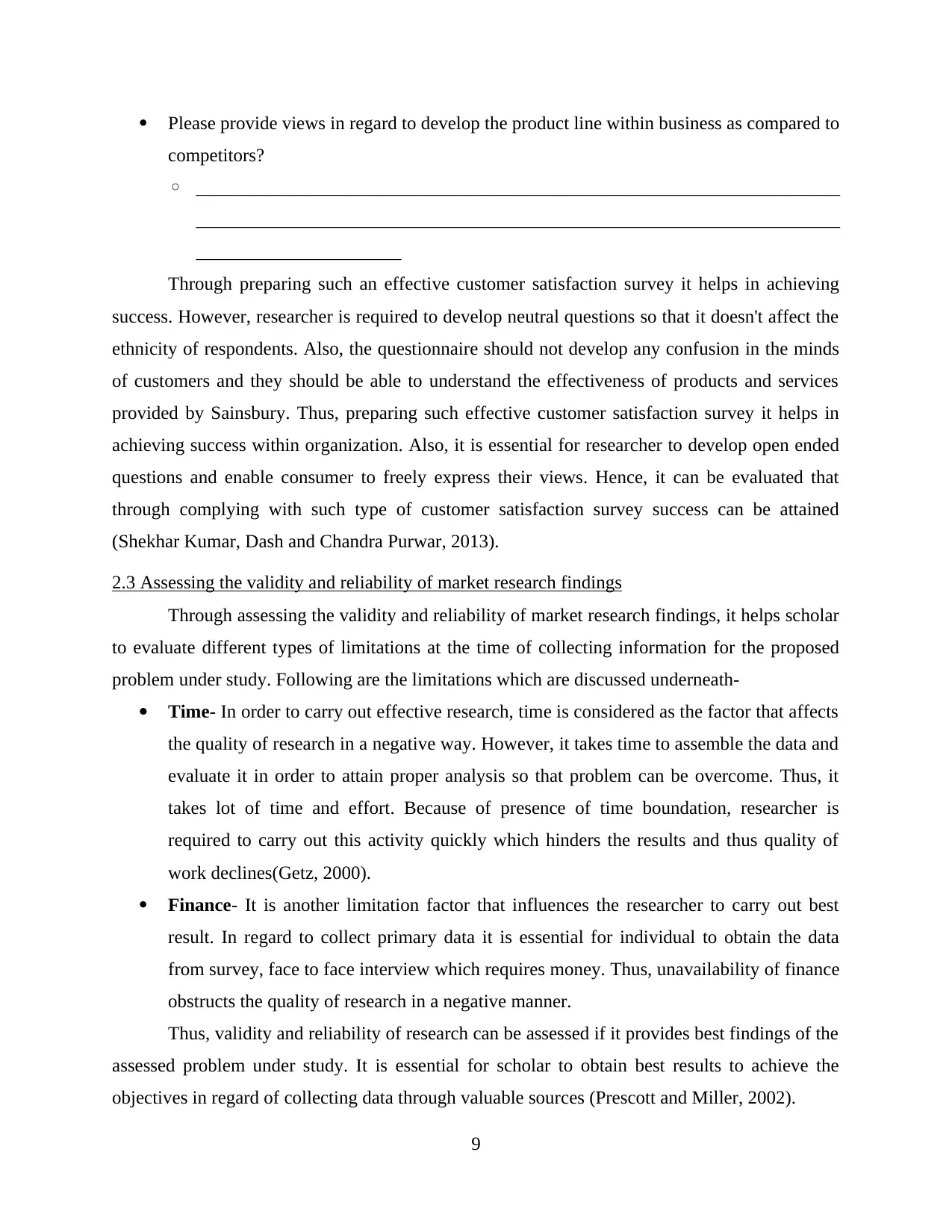
Please provide views in regard to develop the product line within business as compared to
competitors?
◦ _____________________________________________________________________
_____________________________________________________________________
______________________
Through preparing such an effective customer satisfaction survey it helps in achieving
success. However, researcher is required to develop neutral questions so that it doesn't affect the
ethnicity of respondents. Also, the questionnaire should not develop any confusion in the minds
of customers and they should be able to understand the effectiveness of products and services
provided by Sainsbury. Thus, preparing such effective customer satisfaction survey it helps in
achieving success within organization. Also, it is essential for researcher to develop open ended
questions and enable consumer to freely express their views. Hence, it can be evaluated that
through complying with such type of customer satisfaction survey success can be attained
(Shekhar Kumar, Dash and Chandra Purwar, 2013).
2.3 Assessing the validity and reliability of market research findings
Through assessing the validity and reliability of market research findings, it helps scholar
to evaluate different types of limitations at the time of collecting information for the proposed
problem under study. Following are the limitations which are discussed underneath-
Time- In order to carry out effective research, time is considered as the factor that affects
the quality of research in a negative way. However, it takes time to assemble the data and
evaluate it in order to attain proper analysis so that problem can be overcome. Thus, it
takes lot of time and effort. Because of presence of time boundation, researcher is
required to carry out this activity quickly which hinders the results and thus quality of
work declines(Getz, 2000).
Finance- It is another limitation factor that influences the researcher to carry out best
result. In regard to collect primary data it is essential for individual to obtain the data
from survey, face to face interview which requires money. Thus, unavailability of finance
obstructs the quality of research in a negative manner.
Thus, validity and reliability of research can be assessed if it provides best findings of the
assessed problem under study. It is essential for scholar to obtain best results to achieve the
objectives in regard of collecting data through valuable sources (Prescott and Miller, 2002).
9
competitors?
◦ _____________________________________________________________________
_____________________________________________________________________
______________________
Through preparing such an effective customer satisfaction survey it helps in achieving
success. However, researcher is required to develop neutral questions so that it doesn't affect the
ethnicity of respondents. Also, the questionnaire should not develop any confusion in the minds
of customers and they should be able to understand the effectiveness of products and services
provided by Sainsbury. Thus, preparing such effective customer satisfaction survey it helps in
achieving success within organization. Also, it is essential for researcher to develop open ended
questions and enable consumer to freely express their views. Hence, it can be evaluated that
through complying with such type of customer satisfaction survey success can be attained
(Shekhar Kumar, Dash and Chandra Purwar, 2013).
2.3 Assessing the validity and reliability of market research findings
Through assessing the validity and reliability of market research findings, it helps scholar
to evaluate different types of limitations at the time of collecting information for the proposed
problem under study. Following are the limitations which are discussed underneath-
Time- In order to carry out effective research, time is considered as the factor that affects
the quality of research in a negative way. However, it takes time to assemble the data and
evaluate it in order to attain proper analysis so that problem can be overcome. Thus, it
takes lot of time and effort. Because of presence of time boundation, researcher is
required to carry out this activity quickly which hinders the results and thus quality of
work declines(Getz, 2000).
Finance- It is another limitation factor that influences the researcher to carry out best
result. In regard to collect primary data it is essential for individual to obtain the data
from survey, face to face interview which requires money. Thus, unavailability of finance
obstructs the quality of research in a negative manner.
Thus, validity and reliability of research can be assessed if it provides best findings of the
assessed problem under study. It is essential for scholar to obtain best results to achieve the
objectives in regard of collecting data through valuable sources (Prescott and Miller, 2002).
9
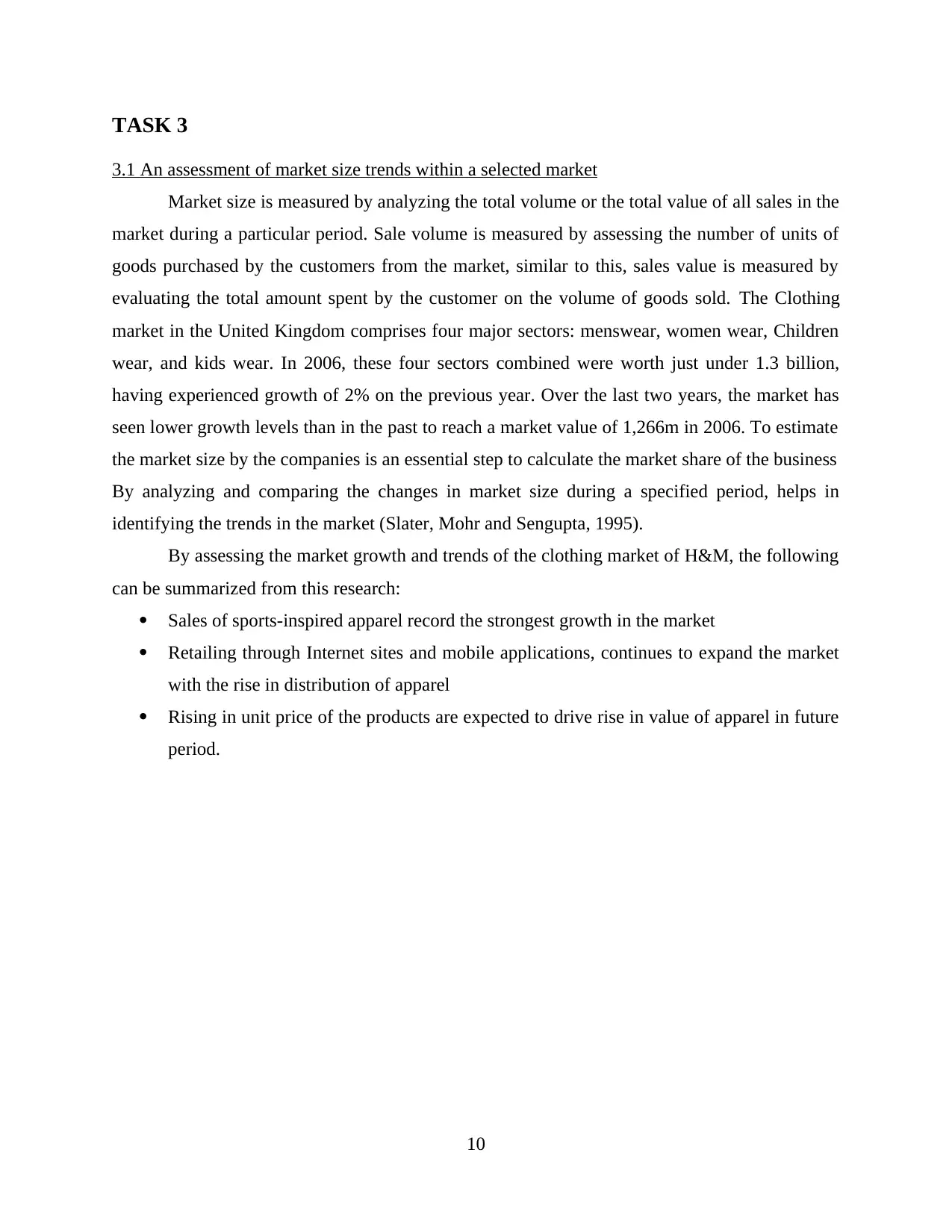
TASK 3
3.1 An assessment of market size trends within a selected market
Market size is measured by analyzing the total volume or the total value of all sales in the
market during a particular period. Sale volume is measured by assessing the number of units of
goods purchased by the customers from the market, similar to this, sales value is measured by
evaluating the total amount spent by the customer on the volume of goods sold. The Clothing
market in the United Kingdom comprises four major sectors: menswear, women wear, Children
wear, and kids wear. In 2006, these four sectors combined were worth just under 1.3 billion,
having experienced growth of 2% on the previous year. Over the last two years, the market has
seen lower growth levels than in the past to reach a market value of 1,266m in 2006. To estimate
the market size by the companies is an essential step to calculate the market share of the business
By analyzing and comparing the changes in market size during a specified period, helps in
identifying the trends in the market (Slater, Mohr and Sengupta, 1995).
By assessing the market growth and trends of the clothing market of H&M, the following
can be summarized from this research:
Sales of sports-inspired apparel record the strongest growth in the market
Retailing through Internet sites and mobile applications, continues to expand the market
with the rise in distribution of apparel
Rising in unit price of the products are expected to drive rise in value of apparel in future
period.
10
3.1 An assessment of market size trends within a selected market
Market size is measured by analyzing the total volume or the total value of all sales in the
market during a particular period. Sale volume is measured by assessing the number of units of
goods purchased by the customers from the market, similar to this, sales value is measured by
evaluating the total amount spent by the customer on the volume of goods sold. The Clothing
market in the United Kingdom comprises four major sectors: menswear, women wear, Children
wear, and kids wear. In 2006, these four sectors combined were worth just under 1.3 billion,
having experienced growth of 2% on the previous year. Over the last two years, the market has
seen lower growth levels than in the past to reach a market value of 1,266m in 2006. To estimate
the market size by the companies is an essential step to calculate the market share of the business
By analyzing and comparing the changes in market size during a specified period, helps in
identifying the trends in the market (Slater, Mohr and Sengupta, 1995).
By assessing the market growth and trends of the clothing market of H&M, the following
can be summarized from this research:
Sales of sports-inspired apparel record the strongest growth in the market
Retailing through Internet sites and mobile applications, continues to expand the market
with the rise in distribution of apparel
Rising in unit price of the products are expected to drive rise in value of apparel in future
period.
10
⊘ This is a preview!⊘
Do you want full access?
Subscribe today to unlock all pages.

Trusted by 1+ million students worldwide
1 out of 17
Related Documents
Your All-in-One AI-Powered Toolkit for Academic Success.
+13062052269
info@desklib.com
Available 24*7 on WhatsApp / Email
![[object Object]](/_next/static/media/star-bottom.7253800d.svg)
Unlock your academic potential
Copyright © 2020–2025 A2Z Services. All Rights Reserved. Developed and managed by ZUCOL.





